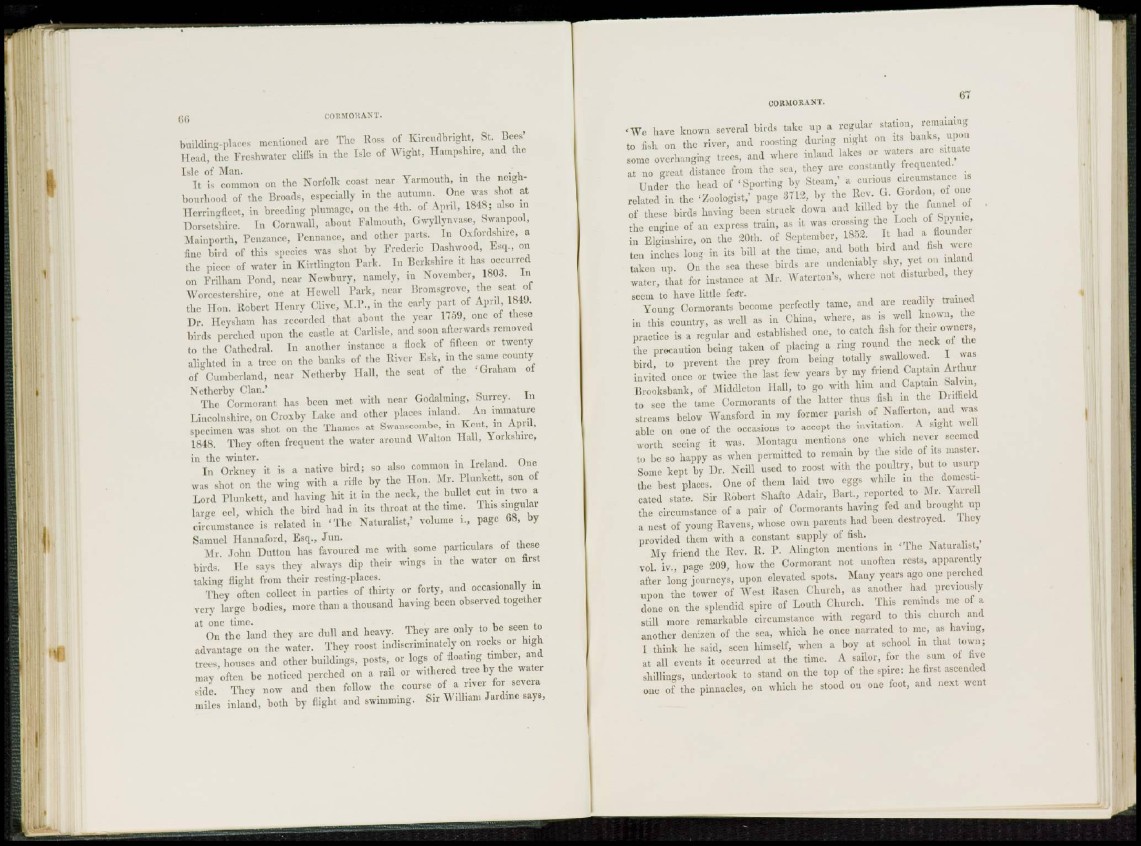
building-place-, mentioned are Tlie Ross of Kircudbright, St. Bees'
Mead, the Freshwater cliffs in the Isle of Wight, Hampshire, and the
I s l e of Man.
It is common on the Norfolk coast near Yarmouth, in the neighbourhood
of the Broads, especially in the autumn. One was shot at
Ilerringflcct, in breeding plumage, on the 4th. of April, 1848; also in
Dorsetshire. In Cornwall, about Falmouth, Gwyllynvase, Swanpool,
Mninporth, Penzance, Pennance, and other parts. In Oxfordshire, a
fine bird of this species was shot by Frederic Dashwood, Esq., on
the piece of water in Kirtlington Park. In Berkshire it has occurred
on Frilham Pond, near Newbury, namely, in November, 1803. In
AVorcestershiro, one at He well Fark, near Bromsgrove, the seat of
the Hon. Robert Henry Clivc, ALP., in the early part of April, 1849.
Dr. Heysham has recorded that about the year 1759, one of these
birds perched upon the castle at Carlisle, and soon afterwards removed
to the Cathedral. In another instance a flock of fifteen or twenty
alighted in a tree on the banks of the River Esk, in the same county
of Cumberland, near Ncthcrby Hall, the seat of the 'Graham of
N etherby Clan.'
The Cormorant has been met with near Godalming, Surrey. In
Lincolnshire, on Croxby Lake and other places inland. An immature
specimen was shot, on the Thames at Swanscombe, in Kent, in April,
I S I S . Thoy often frequent the water around Walton Hall, Yorkshire,
in the winter.
I n Orkney it is a native bird; so also common in Ireland. One
was shot on the wing with a rifle by the Hon. Air. Plunkett, son of
Lord Plunkett, and having hit it in the neck, the bullet cut in two a
large eel, which the bird had in its throat at the time. This singular
circumstance is related in ' T h e Naturalist,' volume i., page 68, by
Samuel Hannafbrd, Esq., Jun.
Mr. John Dutton has favoured me with some particulars of these
birds. He says they always dip their wings in the water on first
taking flight from their resting-places.
They often collect in parties of thirty or forty, and occasionally in
very large bodies, more than a thousand having been observed together
at one time.
On the land they arc dull and heavy. They are only to be seen to
advantage on the water. They roost indiscriminately on rocks or high
trees, houses and other buildings, posts, or logs of floating timber, and
may often be noticed perched on a rail or withered tree by the water
side. They now and then follow the course of a river for severa
miles inland, both by flight and swimming. Sir AVilliani Jardine says,
' W e have known several birds take up a regular station, remaining
to fish on the river, and roosting during night on its banks, upon
some overhanging trees, and where inland lakes or waters arc situate
at no great distance from the sea, they are constantly frequented.'
Under the head of 'Sporting by Steam,' a curious circumstance is
related in the 'Zoologist,' page 3712, by the Rev. G. Gordon, of one
of these birds having been struck down and killed by the funnel of
the engine of an express train, as it was crossing the Loch of Spynie,
in Elginshire, on the 20th. of September, 1852. It had a flounder
ten inches long in its bill at the time, and both bird and fish were
taken up. On the sea these birds arc undeniably shy, yet on inland
water, that for instance at Air. Waterton's, where not disturbed, they
seem to have little fear.
Young Cormorants become perfectly tame, and arc readily trained
in this country, as well as in China, where, as is well known, the
practice is a regular and established one, to catch fish for their owners,
the precaution being taken of placing a ring roimd the neck of the
bird, to prevent the prey from being totally swallowed. I was
invited once or twice the last few years by my friend Captain Arthur
Brooksbank, of Middleton Hall, to go with him and Captain Salvia,
to see the tame Cormorants of the latter thus fish in the Driffield
streams below AVansford in my former parish of Nafferton, and was
able on one of the occasions to accept the invitation. A sight well
worth seeing it was. Montagu mentions one which never seemed
to be so happy as when permitted to remain by the side of its master.
Some kept by Dr. Neill used to roost with the poultry, but to usurp
the best places. One of them laid two eggs while in the domesticated
state. Sir Robert Shafto Adair, Bart., reported to Air. Yarrell
the circumstance of a pair of Cormorants having fed and brought up
a nest of young Ravens, whose own parents had been destroyed. They
provided them with a constant supply of fish.
My friend the Rev. R. P. Alington mentions in ' T h o Naturalist,'
vol. iv., page 209, how the Cormorant not unoften rests, apparently
after long journeys, upon elevated spots. Many years ago one perched
upon the tower of AVest Rasen Church, as another had previously
done on the splendid spire of Louth Church. This reminds me of a
still more remarkable circumstance with regard to this church and
another denizen of the sea, which he once narrated to me, as having,
1 think he said, seen himself, when a boy at school in that town;
at all events it occurred at the time. A sailor, for the sum of five
shillings, undertook to stand on the top of the spire: he first ascended
one of the pinnacles, on which IK; stood on one foot, and next went